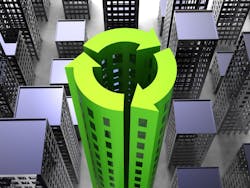The Critical Relationship Between Buildings and Sustainability for the Future (IFMA 2020)
As 2020 draws to a close, everyone is naturally thinking about the future and what the next year will bring. For building owners and facility managers, that means reevaluating their building portfolio to determine whether it’s equipped with the technology to meet the challenges of the future while simultaneously ensuring the health of occupants and the environment.
Because as Chris Collins, VP Systems Transformation, Digital Energy Division at Schneider Electric, noted during his presentation at IFMA’s World Workplace virtual conference, our environment is in crisis. While the COVID-19 pandemic prompted 5% lower global CO2 emissions, it was a short-term reprieve from the status quo. What is needed now is a proactive, long-term commitment to sustainability.
There are a number of challenges in tackling climate change, particularly in the built environment, which is responsible for 40% of the world’s emissions. “The future of building design and operations is where we win or lose the fight on climate change,” Collins says. He points out that efficiency, resiliency and human-centric design also need to be addressed in buildings to ensure they are optimized for the future.
The global pandemic is accelerating the digitization trend, he says, and that “the COVID-19 crisis has changed what it means for buildings to be smart.” He points to a clear need to embrace smart technology and to use data captured by IoT devices to help achieve greater efficiency. As such, Collins suggests in order to meet sustainability goals for the future, our buildings need an “all-electric, all-digital philosophy,” that is balanced by a human-centric mindset.
Digitization Drives Efficiency
Collins says that digitization can drive the energy efficiency potential of the built environment. “How much energy use could we avoid if all commercial buildings were equipped with this digital connection and able to adapt rapidly to changing occupancy rates that we’ve seen over the last two quarters?”
It’s not just about collecting the data, he says, but also having the artificial intelligence and machine learning to organize that data and allow a facility manager to act on information. These systems can provide real-time performance metrics of the building and enable predictive maintenance by machine learning modules.
To leverage the value of this data, Collins says it must be done through smart, sustainable buildings with digitally connected infrastructure that enable facility executives to:
- Monitor power status and quality
- Optimize the HVAC system loads
- Improve occupancy and air quality sensing
- Identifying workplace occupancy
- Optimize between solar and other renewable energy sources in real time
- Leveraging predicted analytics to minimize downtime
“If you’re building a smart, sustainable building in 2020 and it doesn’t do these things, then it’s not a building for the future,” Collins suggests.
[Related: The Benefits of Green Leases (Greenbuild 2020)]
4 Pillars of Smart Buildings in the Future
Where are buildings headed in the future, and what does it mean for building owners and facility managers? Collins says smart buildings that eventually will be all-digital and all-electric will be characterized by four main pillars:
1. Sustainable
Future buildings will maximize electrification and allow for active energy management. These positive energy buildings, which include sustainable retrofits, will be characterized by resource-efficient design, Collins says.
2. Resilient
With hundreds of disasters taking place in 2019, Collins notes that even one can have a tremendous impact on buildings, highlighting the need for improved resiliency. In the future, flexible buildings will allow for more remote operations, better power reliability, as well as enhanced cybersecurity and increased asset protection.
3. Hyper-efficient
Buildings that are optimized for efficiency will allow for better decision making that will impact people needs, space resources, asset efficiency and energy costs, Collins explains.
4. People-centric
“Buildings are being designing to be responsive to give people more peace of mind that we are safe and within healthy environments,” Collins says. The built environment in the future will be safer and healthier, leading to better productivity and collaboration. The question that remains: What is the key to efficient and sustainable buildings in the future? “Data,” Collins says, “but only if captured and used wisely,” noting that 90% of all data captured goes unused in the buildings industry. Further, he says 13% of construction teams’ working hours are spent looking for project data and information, which points to the need for improved data management, which can be addressed through machine learning and AI tools.
Nevertheless, Collins concludes that there’s never been a better time to start investing in these new building technologies if facility executives do their homework upfront. “Jumping into first-class technology without the knowledge of how to use it is not a good investment.”

